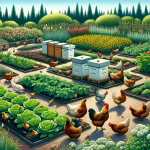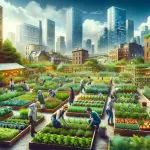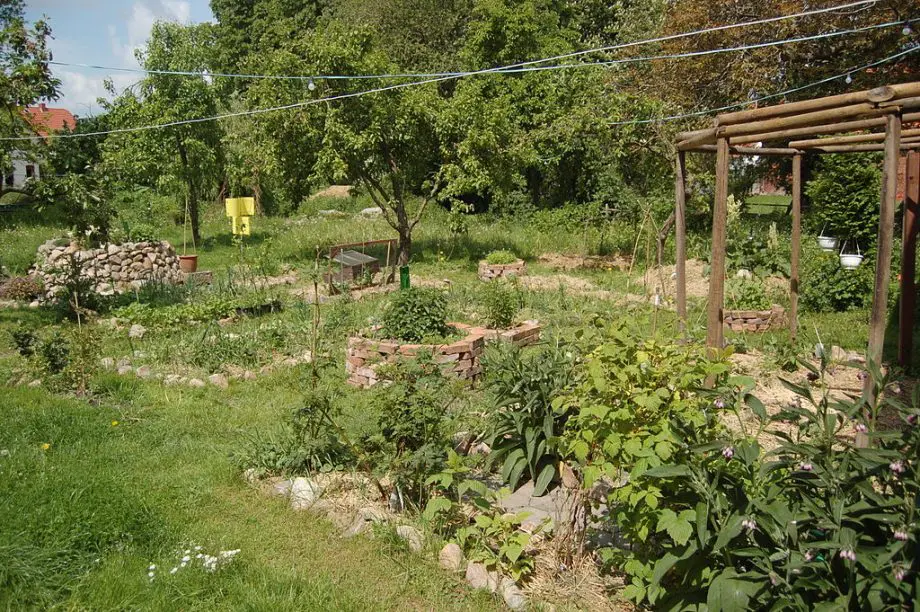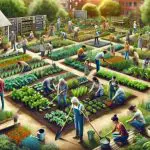
Explore the magic of a small urban permaculture garden! Discover how to transform limited city spaces into vibrant, eco-friendly oases.
Small Urban Permaculture Garden Key Takeaways:
- A small urban permaculture garden is a sustainable, eco-friendly space in urban areas.
- It utilizes permaculture principles to grow a variety of plants in limited spaces like balconies, rooftops, or small yards.
- It focuses on biodiversity, efficient resource use, and creating a self-sustaining ecosystem.
Welcome to the world of small urban permaculture gardens! These green havens are redefining city living, turning tiny spaces into lush, sustainable ecosystems.
Join us as we delve into how you can create your own little slice of nature right in the heart of the urban jungle.
Small Urban Permaculture Gardens
Permaculture, a concept often surrounded by mystique, is an approach to designing human settlements and agricultural systems that are modeled on the relationships found in natural ecologies.
In urban environments, this translates to creating sustainable, efficient, and productive gardens, even in limited spaces.
These gardens are more than just spaces for growing food; they’re a step towards a sustainable future, offering benefits like reduced carbon footprint, enhanced biodiversity, and a stronger sense of community.
This introduction to small urban permaculture gardens will demystify the concept, outlining its importance, core ethics, and how it can be adapted to urban living spaces.
Permaculture was founded by Australians Bill Mollison and David Holmgren in the early 1970s. In their seminal book, Permaculture One (1981), they explain that permaculture melds permanent and agriculture, and is defined as “consciously designed landscapes which mimic the patterns and relationships found in nature, while yielding an abundance of food, fiber and energy for provision of local needs.” The definition of permaculture has expanded to include people, communities and organizations, and so has evolved to permanent (or sustainable) culture. NC State Extension

Permaculture One: A Perennial Agriculture for Human Settlements
Definition, Importance, and Benefits in Urban Areas
Urban permaculture transforms city living by integrating nature into small spaces.
It’s not just about growing plants; it’s about creating sustainable ecosystems that benefit both the environment and urban dwellers.
This section explores what urban permaculture is, its significance in urban areas, and the numerous advantages it offers.
Definition and Essence of Urban Permaculture
Urban permaculture is the art of creating small-scale ecosystems in urban settings.
It involves using available space, whether it’s a balcony, rooftop, or small yard, to grow food and support local wildlife.
This approach combines traditional gardening with ecological principles to create a harmonious, self-sustaining environment in the middle of the city.
Importance in Urban Settings
In urban areas, where green spaces are limited, permaculture serves as a vital tool for sustainability.
It helps in reducing the ecological footprint by minimizing waste, conserving water, and reducing the carbon emissions associated with transporting food.
Urban permaculture gardens become oases in concrete landscapes, providing a connection to nature for city residents.
Small Urban Permaculture Garden Benefits
The benefits of urban permaculture are manifold. These gardens not only provide fresh, organic produce but also improve air quality, promote biodiversity, and create a habitat for urban wildlife.
Moreover, they offer a therapeutic space for city dwellers, fostering a sense of community and connection to the environment.
Core Ethics: Earth Care, People Care, Fair Share
Permaculture is built on three fundamental ethics: Earth Care, People Care, and Fair Share.
These principles guide every aspect of permaculture, especially in urban environments where balancing human needs with ecological responsibility is crucial.
This section delves into each of these core ethics, revealing how they shape the practice and purpose of urban permaculture gardens.
Earth Care
The first ethic, Earth Care, emphasizes the importance of respecting and preserving nature.
In urban permaculture, this translates to practices that enhance the environment rather than deplete it.
It involves using resources sustainably, promoting soil health, conserving water, and encouraging biodiversity.
Urban gardens designed with Earth Care in mind not only benefit the immediate environment but also contribute to the overall health of the planet.
People Care
People Care is all about creating spaces that nourish and support the individuals and communities involved.
Urban permaculture gardens are designed to be accessible and beneficial to everyone.
They provide fresh food, enhance the aesthetic value of urban areas, and offer a peaceful retreat from the hustle and bustle of city life.
These gardens also serve as educational spaces where people can learn about sustainability and ecology.
Fair Share
Fair Share revolves around the concept of equity and sharing. In the context of urban permaculture, this means sharing the abundance of the garden with the community, whether it’s through food, knowledge, or resources.
It also involves being mindful of consumption and waste, ensuring that resources are used efficiently and sustainably.
This ethic fosters a sense of community and mutual support, essential in urban environments where resources can be limited.
Basic Principles in an Urban Context
Permaculture principles, originally designed for rural environments, can be ingeniously adapted to the urban landscape.
This adaptation involves rethinking how we use space, resources, and community networks.
In this section, we’ll explore how the foundational principles of permaculture are applied in an urban context, transforming small spaces into productive, sustainable ecosystems.
Applying Permaculture Principles to Urban Spaces
Urban permaculture involves creatively using limited space to maximize productivity and sustainability.
Principles like stacking functions (where each element serves multiple purposes) and using edges and marginal spaces (like walls and fences for vertical gardening) are key.
This approach not only maximizes space but also enhances the efficiency and productivity of urban gardens.
Resource Utilization and Waste Minimization
A core aspect of urban permaculture is the efficient use of resources and minimizing waste.
This includes practices like composting organic waste, harvesting rainwater, and using recycled materials for garden infrastructure.
These practices reduce the ecological footprint of urban gardens and turn potential waste into valuable resources.
Community Engagement and Shared Spaces
In an urban setting, community engagement plays a vital role in permaculture.
Shared gardens, whether in public spaces or community centers, provide opportunities for education, skill-sharing, and strengthening community bonds.
They become platforms for collective learning and action, crucial in creating resilient urban ecosystems.
Understanding the Basics of Permaculture
Permaculture goes beyond just planting; it’s a philosophy that integrates land, resources, people, and the environment through mutually beneficial synergies.
This section aims to clarify the basic definition and principles of permaculture, differentiate it from traditional gardening methods, and highlight its relevance in today’s urban spaces.
Definition and Principles
Permaculture, a contraction of ‘permanent agriculture’, is a design system centered around simulating or directly utilizing the patterns and features observed in natural ecosystems.
It focuses on the harmonious integration of the landscape with people, providing food, energy, shelter, and other material and non-material needs sustainably.
Key principles include observing and interacting with nature, capturing and storing energy, obtaining a yield, and applying self-regulation and feedback.
Differentiating Permaculture from Traditional Gardening
Unlike traditional gardening, which often relies on monocultures and external inputs like fertilizers and pesticides, permaculture emphasizes diversity, natural ecosystems, and sustainable, closed-loop systems.
It seeks to create a balanced ecosystem that can sustain itself with minimal external intervention, focusing on long-term sustainability rather than immediate yields.
Relevance in Urban Contexts
In urban environments, permaculture principles can be applied to make the most of limited space and resources.
This includes using vertical spaces, integrating small-scale renewable energy solutions, and creating communal spaces that support both ecological and social functions.
Urban permaculture challenges the conventional approach to city living, offering a more sustainable and resilient alternative.
Designing Your Urban Permaculture Garden

Creating an urban permaculture garden is an exciting journey of transforming small and often underutilized spaces into thriving ecosystems.
This section focuses on practical aspects of designing an urban permaculture garden, including planning for different zones, selecting suitable plants, and adopting innovative methods to overcome space limitations.
Permaculture Zone Planning in Small Spaces
In permaculture, zones are used to organize the garden based on the frequency of human use and the needs of plants and animals.
In an urban context, this might mean placing frequently harvested herbs and vegetables close to the kitchen (Zone 1), while less frequently tended elements like compost bins could be placed further away (Zone 2 or 3).
This efficient layout maximizes productivity and ease of maintenance in limited urban spaces.
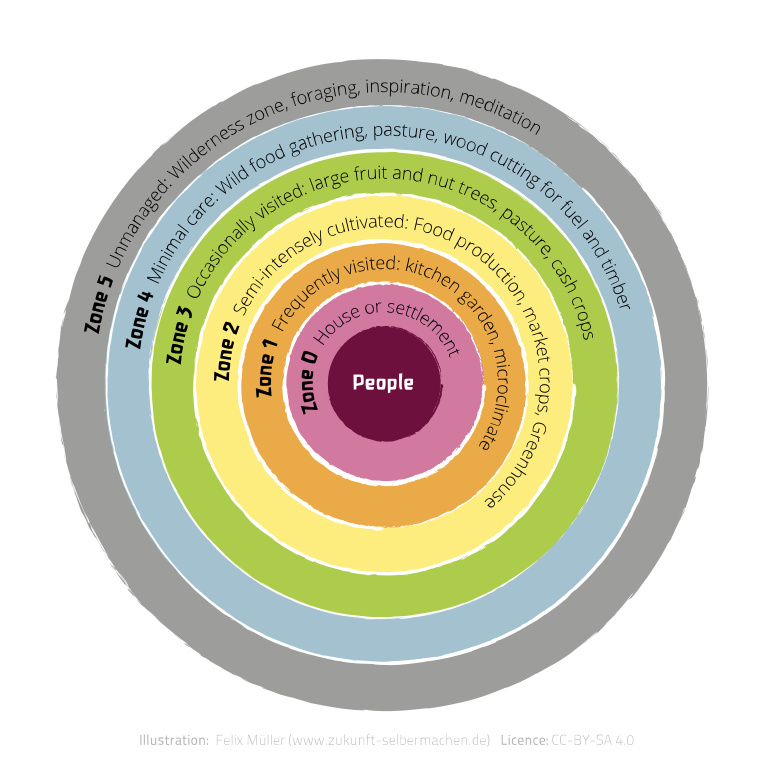
Choosing Suitable Plants
Selecting the right plants for an urban permaculture garden involves considering the local climate, sunlight availability, and soil conditions.
It’s also about choosing plants that serve multiple purposes – such as food production, attracting beneficial insects, or providing shade.
Companion planting, where certain plants are grown together for mutual benefit, is another key aspect of this selection process.
Innovative Methods for Limited Spaces
Urban permaculture often requires innovative approaches to overcome space constraints.
This includes vertical gardening, where plants are grown on walls or trellises, and container gardening, which allows for mobility and efficient use of space.
Other methods like rooftop gardening or window farms can turn underutilized urban spaces into productive green areas.
Analyzing and Preparing Your Urban Space

Before diving into planting, it’s crucial to analyze and prepare your urban space for a permaculture garden.
This preparatory phase involves understanding the unique characteristics of your space, including its size, exposure to sunlight, soil quality, and any local regulations that may affect gardening practices.
This section will guide you through the initial steps of assessing and preparing your urban space for permaculture gardening.
Assessing Small Spaces
Start by evaluating the space you have available. Measure the area and note aspects like sunlight exposure, shade patterns, and existing vegetation.
Consider how different parts of the space can be utilized efficiently.
For instance, areas with the most sunlight are ideal for vegetables and fruits, while shadier spots can be used for plants that require less light.
Understanding Local Laws and Regulations
It’s important to be aware of any local laws or regulations that might impact your gardening plans.
This could include restrictions on the types of structures allowed, water usage, or types of plants.
Checking with local authorities or a gardening group can provide valuable insights and help you stay compliant.
Soil Quality and Improvement
Soil health is vital for a successful permaculture garden. Test your soil for pH, nutrient levels, and texture.

Urban soils often need amending to improve fertility and structure. Adding organic matter, like compost or leaf mold, can significantly enhance soil quality, promoting healthier plant growth.
Sunlight and Microclimate Considerations
Understanding the microclimate of your area, including patterns of sunlight and shade, wind, and precipitation, is crucial for selecting suitable plants and designing your garden layout.
Observing these patterns over a day or a season can provide insights into the best placement for different elements of your garden.
Sustainable Practices and Resource Management
Incorporating sustainable practices and effective resource management is at the heart of urban permaculture.
This section delves into techniques like water management, soil building strategies, and the use of sustainable materials and tools.
These practices not only enhance the efficiency and productivity of your garden but also contribute to a healthier urban environment.
Water Management
Efficient water use is key in urban permaculture. Techniques like installing swales (shallow trenches) can help in capturing rainwater and directing it to where it’s needed.
- Greywater systems reuse household water for gardening
- Rainwater harvesting collects rain for later use, reducing reliance on municipal water supplies.
- Drip irrigation can help with water management practices too.
Soil Building Strategies
Healthy soil is the foundation of a productive garden. Urban gardeners can enhance soil quality through composting kitchen scraps and yard waste, creating nutrient-rich compost.
Incorporating organic matter like compost into the soil improves its structure, water retention, and fertility, making it better suited for growing plants.
Sustainable Materials and Tools
Using sustainable materials and tools is another important aspect of urban permaculture.
This includes choosing recycled or upcycled materials for garden beds and structures and using hand tools or electric-powered tools instead of gas-powered ones to reduce carbon emissions.
These choices not only benefit the environment but also promote a more sustainable lifestyle.
Maximizing Space in Urban Settings
Urban environments often come with the challenge of limited space, but with creative thinking and permaculture principles, these small areas can be transformed into productive green spaces.
This section focuses on techniques like vertical gardening, using balconies and rooftops, and container gardening tips, all aimed at maximizing the potential of urban spaces for permaculture gardening.
Vertical Gardening

Vertical gardening is a space-saving technique ideal for urban environments. It involves growing plants on vertical surfaces such as walls, fences, or trellises.
This method not only maximizes space but also can create microclimates and living green walls, adding beauty and biodiversity to urban settings.
Utilizing Balconies and Rooftops

Balconies and rooftops offer valuable space for urban gardening. Balcony gardens can be set up using containers and hanging pots, while rooftops can be transformed into larger garden spaces.
Both require considerations for weight, wind exposure, and water drainage but can be highly productive areas for growing a variety of plants.
Container Gardening Tips
Container gardening is versatile and accessible. It allows for mobility and flexibility in plant choice and placement.
When choosing containers, consider the size and growth habit of the plants.
Ensure proper drainage and use high-quality potting soil.
Containers can be made from various materials, including recycled items, which adds an element of sustainability to your urban garden.
Water Management and Soil Health
Effective water management and maintaining soil health are key components of a successful urban permaculture garden.
This section explores sustainable practices like rainwater harvesting and composting, which not only conserve resources but also contribute to the overall health and productivity of your garden.
Rainwater Harvesting
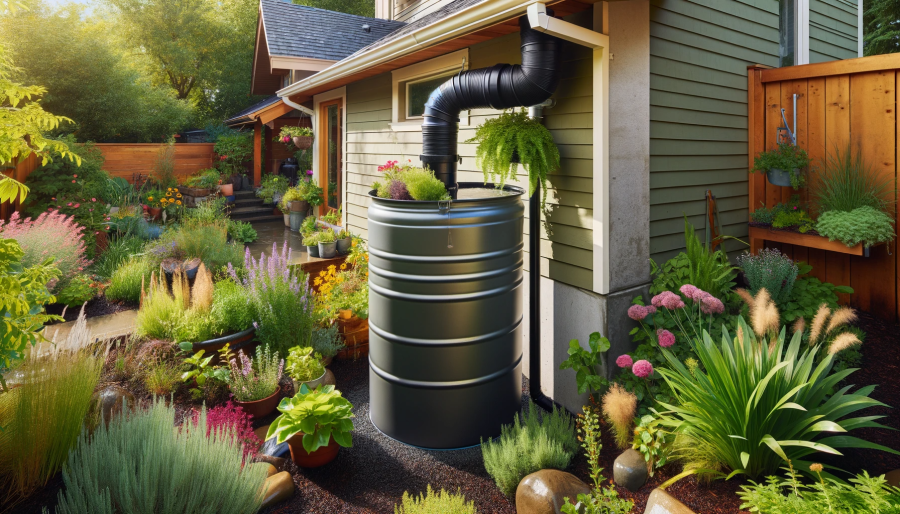
Rainwater harvesting involves collecting and storing rainwater for later use in the garden.
This can be done using rain barrels or more complex systems connected to your gutters.
Harvesting rainwater reduces dependence on municipal water supplies and provides your plants with chemical-free water, ideal for organic gardening.
Composting for Soil Health
Composting is an effective way to recycle kitchen and garden waste into rich, nutrient-dense soil.
It involves layering green (nitrogen-rich) and brown (carbon-rich) materials in a bin or pile and allowing them to decompose.
This process not only reduces waste but also creates compost that can greatly improve soil fertility and structure, leading to healthier plant growth.
Implementing Sustainable Soil Practices
Beyond composting, other sustainable soil practices include mulching, which helps retain moisture and suppress weeds, and practicing crop rotation and companion planting to maintain soil health and prevent pest and disease problems.
These practices are especially important in urban settings where soil quality may be initially poor.
Community Involvement and Educational Aspects
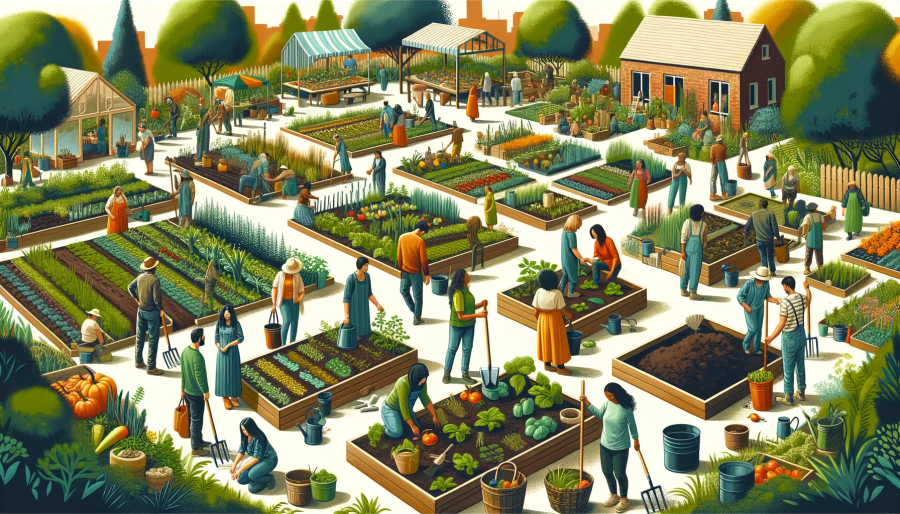
Urban permaculture isn’t just about individual gardens; it’s a community effort.
This section highlights the importance of community involvement and the educational benefits of urban permaculture.
Engaging with neighbors, sharing knowledge, and learning together can lead to more resilient and sustainable urban communities.
Engagement and Educational Benefits
Urban permaculture gardens can become hubs for community engagement and learning.
Workshops, garden tours, and collaborative gardening days encourage community members to learn about sustainable practices and share their knowledge and experiences.
These activities foster a sense of community, connect people to nature, and promote environmental stewardship.
Case Studies and Success Stories
Sharing success stories and case studies of urban permaculture projects can be highly motivational.
These stories can showcase how diverse urban spaces have been transformed into productive and sustainable ecosystems, highlighting the creativity and innovation involved.
They also provide valuable lessons and inspiration for others looking to start their own urban permaculture projects.
Urban Agriculture: Findings From Four City Case Studies
Educational Aspects for All Ages
Urban permaculture gardens can serve as outdoor classrooms for people of all ages.
They provide hands-on learning experiences about food production, ecology, and sustainability.
Schools, community centers, and local organizations can use these gardens to teach practical skills and environmental awareness, fostering the next generation of eco-conscious citizens.
Sustainable Gardening Practices
Adopting sustainable gardening practices is crucial in urban permaculture.
This section delves into natural pest control methods and the importance of crop rotation, ensuring that your garden not only thrives but also supports the local ecosystem in a balanced and sustainable manner.
Natural Pest Control
In urban permaculture, managing pests naturally is preferred over using chemical pesticides.
This can be achieved through companion planting, where certain plant combinations naturally deter pests, and by encouraging beneficial insects and birds into the garden.
Practices like creating insect hotels or bird feeders can enhance natural pest control.
Crop Rotation
Crop rotation is an essential practice for maintaining soil health and preventing pest and disease buildup.
By rotating different types of crops in different areas of your garden over time, you can ensure that soil nutrients are used efficiently and replenished naturally.
This practice also helps in breaking the life cycles of pests and diseases associated with specific crops.
Encouraging Biodiversity
Biodiversity is a key component of sustainable urban gardens. Planting a variety of species not only creates a more resilient garden but also supports local wildlife.
Including native plants, providing habitats for beneficial insects, and using organic matter to improve soil health are all practices that contribute to a thriving, diverse garden ecosystem.
Community and Social Aspects

Urban permaculture gardens are more than just spaces for growing food; they are platforms for building stronger communities and fostering social connections.
This section focuses on the role of community gardens in urban permaculture, highlighting how they promote resource sharing and enhance social bonds within urban communities.
Community Gardens
Community gardens are a cornerstone of urban permaculture, providing shared spaces where people can come together to garden.
These gardens are not just about food production; they’re about community building, education, and sharing resources.
They offer a space for people of diverse backgrounds to connect, share knowledge, and work towards a common goal.
Resource Sharing
In urban permaculture, the concept of sharing extends beyond just sharing the harvest.
It includes sharing tools, seeds, knowledge, and labor. This collaborative approach reduces individual costs, fosters a sense of collective ownership, and strengthens community resilience.
Social Benefits
Participating in community gardens and other urban permaculture projects has numerous social benefits.
It can reduce feelings of isolation, provide opportunities for intergenerational and cultural exchange, and promote physical and mental well-being.
These social interactions enrich the urban living experience, creating a sense of belonging and community.
FAQs on Urban Permaculture
Urban permaculture, while increasingly popular, can still raise many questions, especially for those new to the concept.
This section addresses common queries and concerns about urban permaculture.
It aims to clarify doubts, provide practical tips, and encourage more urban dwellers to embrace permaculture practices.
Q: What is Urban Permaculture and How Does it Differ from Traditional Gardening?
A: Urban permaculture is a sustainable approach to city gardening that mimics natural ecosystems.
Unlike traditional gardening, it emphasizes biodiversity, ecological balance, and sustainability, often using less water and no chemical fertilizers or pesticides.
Q: How Can I Start a Permaculture Garden in a Small Urban Space?
A: Begin by observing your space to understand sunlight, wind patterns, and potential.
Utilize vertical spaces and containers if ground space is limited. Start with easy-to-grow plants and gradually integrate more elements as you gain confidence and experience.
Q: Is Urban Permaculture Expensive to Implement?
A: It can be very cost-effective. Many practices involve repurposing materials and minimizing waste.
Community sharing of tools and resources also helps reduce costs. Over time, the garden can produce savings in food costs.
Q: How Can I Manage Pests Naturally in My Urban Garden?
A: Encourage beneficial insects by planting a variety of flowers and herbs. Use barriers and traps for larger pests, and practice companion planting to deter harmful insects naturally.
Q: Can Urban Permaculture Really Make a Difference in the Environment?
A: Absolutely. Urban permaculture gardens contribute to biodiversity, improve air and soil quality, and reduce the urban heat island effect.
They also promote sustainable living practices within the community.
Q: What Are Some Key Plants for an Urban Permaculture Garden?
A: Key plants include native species, pollinator-friendly flowers, and edible plants suited to your climate and space.
Herbs, leafy greens, and small fruit trees or bushes are great for starters.
Q: How Do I Deal with Limited Water Resources in My Urban Garden?
A: Implement rainwater harvesting systems, use drought-resistant plants, and practice mulching to retain soil moisture.
Efficient watering methods, like drip irrigation or watering at cooler times of the day, also help conserve water.
Key Takeaways
As we near the end of our exploration of small urban permaculture gardens, it’s important to reflect on the key insights and lessons learned.
This section summarizes the main takeaways from the post, emphasizing the significance of urban permaculture and its impact on both personal well-being and the urban environment.
Summary of Urban Permaculture Benefits
Urban permaculture offers numerous benefits, including the creation of sustainable, biodiverse gardens that improve the local environment, provide fresh produce, and enhance the quality of urban living.
These practices promote ecological balance, reduce the carbon footprint, and foster a sense of community among urban dwellers.
Empowerment Through Knowledge and Skills
Engaging in urban permaculture empowers individuals with the knowledge and skills to grow their own food sustainably, contribute to environmental conservation, and make positive changes in their communities.
It demystifies the process of creating green spaces in urban areas and shows how small actions can have a significant impact.
Encouragement to Embrace Permaculture Principles
The post encourages readers to embrace permaculture principles in their urban environments.
It highlights that regardless of the size or location of one’s living space, there are opportunities to implement sustainable gardening practices and make a meaningful contribution to a healthier urban ecosystem.
Conclusion and Call to Action
As we conclude our journey through the world of small urban permaculture gardens, it’s clear that these spaces are more than just areas for growing food.
They are vital for creating sustainable, resilient urban communities.
This final section aims to motivate readers to start their own urban permaculture garden, no matter how small, and to become active participants in a greener, more sustainable urban future.
Embracing the Urban Permaculture Movement
Urban permaculture is not just a gardening trend; it’s a movement towards a more sustainable and harmonious way of living in our cities.
By embracing these practices, you can play a crucial role in this movement, contributing to environmental conservation and community well-being.
Starting Small, Dreaming Big
Don’t be daunted by the scale of permaculture principles.
Start small, perhaps with a container garden or a few herbs on your windowsill, and gradually expand as you learn and grow.
Every plant you nurture is a step towards a greener urban landscape.
Joining the Community of Urban Gardeners
Remember, you’re not alone in this journey. There are communities of urban gardeners and permaculture enthusiasts who are eager to share their knowledge, experience, and support.
Engage with these communities, participate in local events, and share your own experiences to inspire others.
Call to Action: Begin Your Permaculture Journey Today
We invite you to begin your urban permaculture journey today.
Whether it’s researching plants suitable for your space, attending a local workshop, or simply starting a compost bin, each action you take is a step towards a more sustainable and fulfilling urban life.
Let’s cultivate not just gardens, but a vision for a greener, more sustainable urban world.


